For over a decade musician Kyle Davison has been building and playing his Pristophone. Using variously sized circular saw blades and technical sonic acumen, this instrument is capable of producing dizzying classical arrangements that are well known to experimental works he has composed. This enormous sound producing artwork is now housed in an attic in Logan Square. This week the COMP Magazine visited Davison’s studio he shares with members of the Chicago-based ensemble, Environmental Encroachment, to discuss the creation this massive endeavor, his formal training in music, some early 20th century composers he admires, the value he places on live performance, and experience first-hand him precisely playing of series of pieces written by Johann Sebastian Bach.
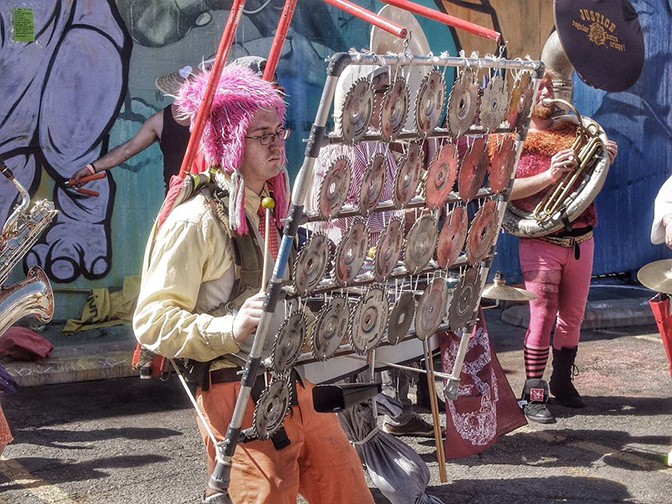
Kyle Davison playing Pristophone at the 2015 Honk! Texas festival in Austin, Texas
You’re a relatively new arrival to the city. Can we back up a bit? Perhaps, start with a bit of background. You grew up and studied music in Wisconsin. In conversation you mentioned that your parents were teachers, yet there was no direct connection to music? Are there any early experiences or people who set you down this sonic path?
It’s true; there are no other musicians in my family. I was adopted, so maybe my interest in music is an argument for nature over nurture. But, on the nurture side, we had a piano in the house and I took lessons for a few years. By far the largest influence was school band. I was an odd kid who felt most at home among all the other odd kids in the band room. This remains true for me even today. I have many odd musician friends who inspire and motivate me.

Detail of Kyle Davison’s Pristophone, Chicago, 2018
You’ve created a rather large instrument called the Pristophone over a sustained period of time. What prompted you to make this instrument? Can you walk us through the process of creation?
It began in the summer of 2007 when I bought two dusty circular saw blades for fifty cents at the garage sale of an unemployed saw mill worker. I discovered that they seemed to have a pitch if they were suspended and struck in a certain way. That began a monomaniacal decade-long quest to expand the instrument to what it is today. I always had the next step in mind, but I did not always have the three crucial elements of time, money, and work space. There were many challenges along the way—preparing, tuning, and suspending the blades; constructing a rack that was strong but portable; building a functional damper system—but the most difficult task by far was finding a full set of 65 chromatic pitches, which took a lot of visits to resale shops and antiques stores and several long-distance trips to follow up on responses to my wanted-to-buy Craigslist posts. I document the process more fully on my Facebook page:
https://www.facebook.com/media/set/?set=a.10153438350391740.1073741828.712741739&type=1&l=5ebc5481fe
Speaking to my motivations in a broader sense, I want to offer an original voice. While there is a lot of amazing music still being written for acoustic instruments that are hundreds of years old, there is something about entirely new sounds that can make people stop, listen, and consider things in a new way.
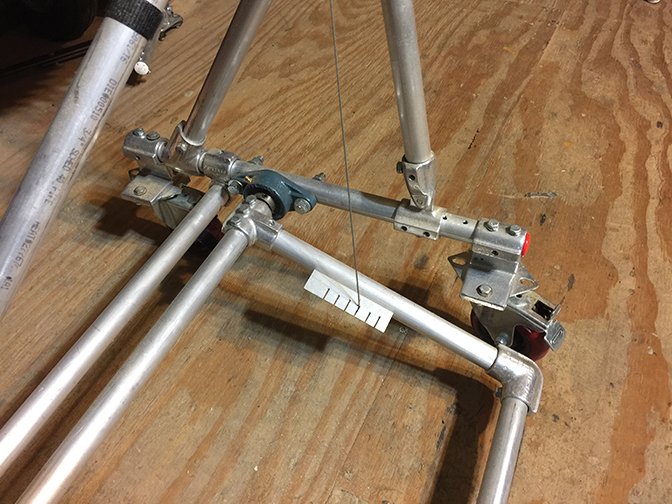
Detail of Kyle Davison’s Pristophone, Chicago, 2018
Where did the name Pristophone stem from?
Pristophone is a combination of the ancient Greek words prister (saw) and phone (sound). It’s modeled after xylophone and saxophone. It gives the instrument a touch of classical gravitas, I think.
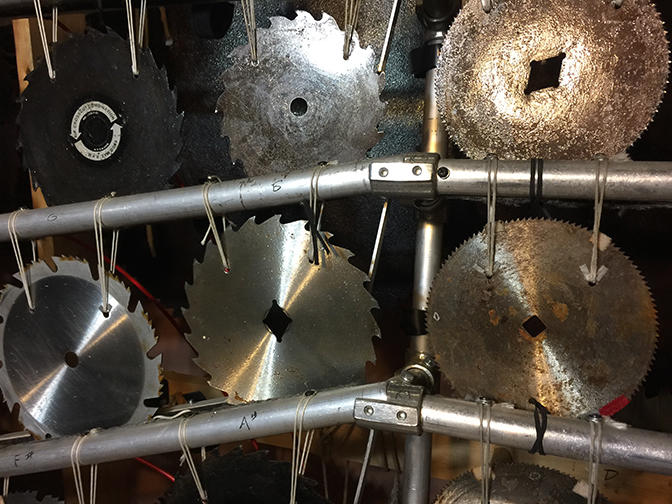
Detail of Kyle Davison’s Pristophone, Chicago, 2018
You enjoy the live performance aspect of making music. What do you find most engaging in performing?
Live performance, especially with an ensemble, involves stepping outside yourself and communing with others in a very intimate way. The best performances resemble a good sexual experience.
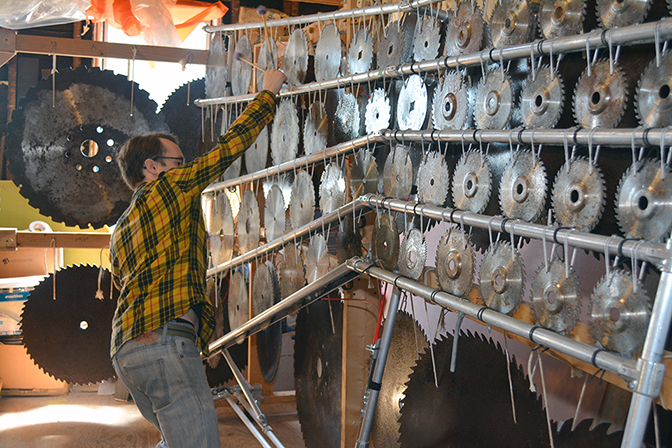
Kyle Davison playing Pristophone, Chicago, 2018
You noted a handful of early to mid 20th century composers (Cage, Glass, Satie) who have fascinated you for some time. These are often considered experimental artists in terms of approach. What drew you to this type of music? Do you see any specific influences their work has upon your practice?
I have conflicted feelings about contemporary classical music. On one hand, I absolutely love innovation and the feeling of discovering something new, both as a listener and as a performer. I have had many meaningful experiences with music that is far from the mainstream. But I have also seen how people can use musical taste, intentionally or not, as a way to maintain social distinctions. Classical music certainly serves this purpose often. So while I am myself firmly rooted in an experimental classical tradition, much of my work involves bringing that in a more populist direction. In college I played with an ensemble that played only from scores with non-traditional notation. After that I was involved with Forward! Marching Band in Madison which invited musicians of all skill levels and had explicit political goals. I’m currently part of Environmental Encroachment, which is a Dionysian spectacle that often breaks down boundaries between performer and audience. All of these experiences have broadened my ideas of what music can do and I try to bring that awareness into my own personal practice.
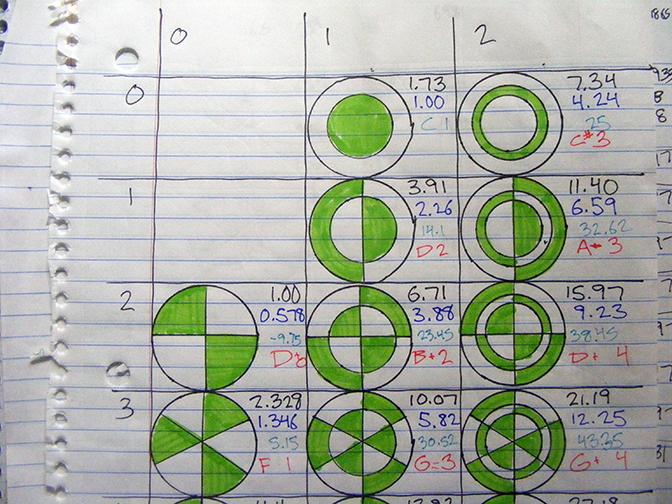
Kyle Davison, Pristophone graph of the frequency ratios of
the different modes of vibration of the saws, Chicago, 2018
You are currently working upon a series of compositions. Can you share with us your process? What is the intent of these pieces?
This summer I am recording an album of Erik Satie’s piano music transcribed for the Pristophone and percussion. The broad, stark texture of Satie’s music is wonderful for bringing out the unique timbre of the saws. I think Satie would pleased with hearing his music on such a strange instrument, given his own tendency towards absurdism. The album will come out at the end of the year.
In 2019 I will be fleshing out the arrangements for a set of songs for Pristophone, percussion, brass, and vocals. Basically it will be rock, minus guitars, plus an experimental sensibility. The best way to find these future releases is to sign up for my mailing list:
Mailing List: http://eepurl.com/dy23mb
Davison playing Bach’s First Cello Suite:
In addition to the noted you perform with Environmental Encroachment. What’s the plan for the remainder of 2018? Any upcoming shows or releases of music?
I’m currently taking a break from EE to work on the Satie project, but I will be back with the group later this summer. We will be in the recording studio soon working on pieces from me and other composers in the band. The album will be released next year. EE has upcoming shows at the Bughouse Square Debates on July 28th and at Reggie’s Music Joint here in Chicago on August 4th, and will be playing at Honkfest in Somerville, Massachussetts, in October.
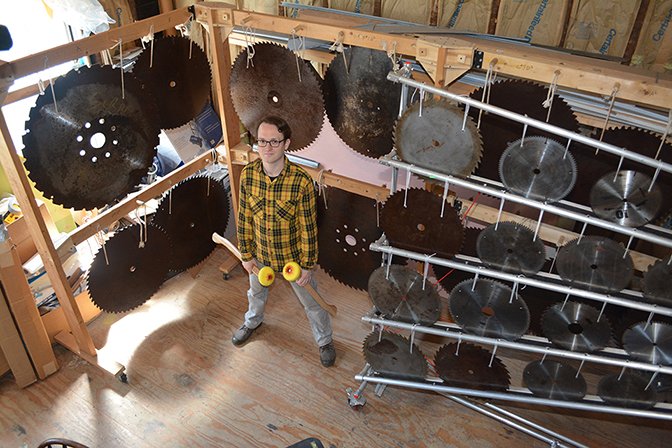
Kyle Davison, musician, in Logan Square attic studio, Chicago, IL, 2018
Interview and artist portrait by Chester Alamo-Costello


